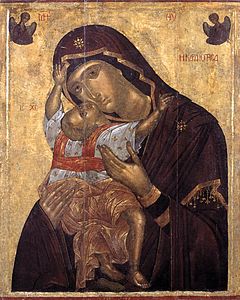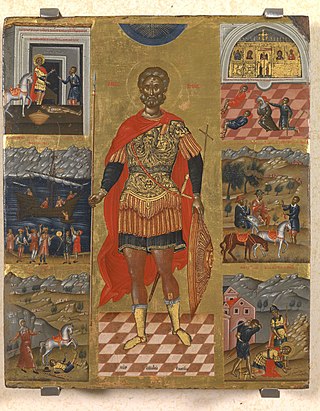
Cretan School describes an important school of icon painting, under the umbrella of post-Byzantine art, which flourished while Crete was under Venetian rule during the late Middle Ages, reaching its climax after the Fall of Constantinople, becoming the central force in Greek painting during the 15th, 16th and 17th centuries. The Cretan artists developed a particular style of painting under the influence of both Eastern and Western artistic traditions and movements; the most famous product of the school, El Greco, was the most successful of the many artists who tried to build a career in Western Europe, and also the one who left the Byzantine style farthest behind him in his later career.

Angelos Akotantos was a Greek painter, educator, and protopsaltis. He painted icons in the maniera greca, at a time when that style was moving away from the traditions of the Byzantine Empire and towards the more refined aesthetic of the Cretan School. Akotantos taught painting to Andreas Pavias, Andreas Ritzos, and Antonios Papadopoulos, and his style influenced later artists such as Georgios Klontzas, Theophanes the Cretan, Michael Damaskinos and El Greco. Angelos's brother Ioannis was also a famous painter. There are 50 extant paintings reliably attributed to Akotantos, 30 of which bear his signature.

Andreas Ritzos also known as (Rico, Ricio, Rizo). He was a Greek icon painter, from Crete. Ritzos is considered one of the founding fathers of the Cretan School. He was affiliated with Angelos Akotantos. Most of his work stylistically follows the traditional maniera greca. His children, grandchildren, and great-grandchildren were also painters. He was one of the most influential painters of the Cretan School along with Andreas Pavias and Angelos Akotantos. He influenced the works of Georgios Klontzas, Nikolaos Tzafouris, Theophanes the Cretan, Michael Damaskinos and El Greco. According to the Institute for Neohellenic Research, sixty of his paintings have survived.

Nikolaos Tzafouris(Greek: Νικόλαος Ζαφούρης η Τζαφούρης) 1468-1501), also Niccolo, Niccolò, Niccolö, Zafuri, Zafuris, was a Greek Renaissance painter. He was one of the founders of the Cretan School. He was influenced by Angelos Akotantos. His works influenced Emmanuel Tzanes, Elias Moskos, Georgios Klontzas and Theodoros Poulakis. Tzafouris was one of the most respected artists in Crete. His most notable work is Madre della Consolazione. The painting exhibits a combination of Byzantine and Italian styles. Another notable painter in Crete around the same time was Andreas Pavias. According to the Institute of Neohellenic Research, thirteen paintings are attributed to Tzafouris.

The Crucifixion is a tempera painting by Andreas Pavias, who was active in Crete during the second half of the 15th century and is considered part of the Cretan School. It is now in the National Gallery of Greece. The painting influenced countless arts. Georgios Klontzas, Emmanuel Lambardos, Ioannis Moskos created similar works. Pavias introduced multiple figures to his Crucifixion. Georgios Klontzas began to employ a similar method in his famous work In Thee Rejoiceth. A work that was emulated by Theodore Poulakis and Franghias Kavertzas. The painting exhibited characteristics of the traditional maniera greca and the Venetian style.

Christ Bearing the Cross is a tempera painting attributed to Nikolaos Tzafouris. Nikolaos Tzafouris was a Greek painter. He is one of the founding members of the Cretan School along with Andreas Ritzos, Andreas Pavias, and Angelos Akotantos. He was influenced by Angelos Akotantos. According to the Institute of Neohellenic Research, thirteen paintings are attributed to Tzafouris. Tzafouris was active between 1480 and 1501. Tzafouris had a workshop in Heraklion. Tzafouris painted religious themes for local churches. The painting is a mixture of Italian and Greek Byzantine prototypes. The work followed the traditional maniera greca and was influenced by Venetian painting. His most notable works are the Madre della Consolazione and Christ Bearing the Cross. Christ Bearing the Cross is in Manhattan on display at Metropolitan Museum of Art.

Madre della Consolazione is a tempera painting created by Greek painter Nikolaos Tzafouris. Tzafouris was active during the second half of the 15th century. He was a prominent member of the Cretan School. He was influenced by Angelos Akotantos. The painter was exposed to works of Giovanni Bellini. At some point, he traveled to Venice and studied painting in the city. He is considered one of the most important painters because he introduced two prototypes that were mass produced by Cretan workshops. The painter is attributed with starting the specific style on the island of Crete. Most historians refer to the style as the Italian style Madonna in comparison to its Greek counterparts. Madre della Consolazione is very important because it served as a prototype for workshops on the island and it was heavily copied. Famous Greek painter Nikolaos Gripiotis and his contemporaries mass-produced the prototype. It is very difficult to attribute unsigned works because the prototype was mass-produced.

Italo-Byzantine is a style term in art history, mostly used for medieval paintings produced in Italy under heavy influence from Byzantine art. It initially covers religious paintings copying or imitating the standard Byzantine icon types, but painted by artists without a training in Byzantine techniques. These are versions of Byzantine icons, most of the Madonna and Child, but also of other subjects; essentially they introduced the relatively small portable painting with a frame to Western Europe. Very often they are on a gold ground. It was the dominant style in Italian painting until the end of the 13th century, when Cimabue and Giotto began to take Italian, or at least Florentine, painting into new territory. But the style continued until the 15th century and beyond in some areas and contexts.

Antonios Papadopoulos was a Greek painter who represented the Cretan Renaissance. Papadopoulos, Andreas Pavias, Andreas Ritzos, and Nikolaos Tzafouris were all students of famous painter Angelos Akotantos. Papadopoulos reflects the sophistication and evolution of Byzantine painting to a more refined Venetian style. Although Cretan painting continued the tradition of the maniera greca, every icon reflected its own sophistication and uniqueness. Papadopoulos and his contemporaries influenced countless artists, namely Emmanuel Lambardos, Emmanuel Tzanfournaris, Thomas Bathas, and Markos Bathas. His most notable artwork is the Nursing Madonna or Galaktotrophousa. El Greco painted similar subject matter.
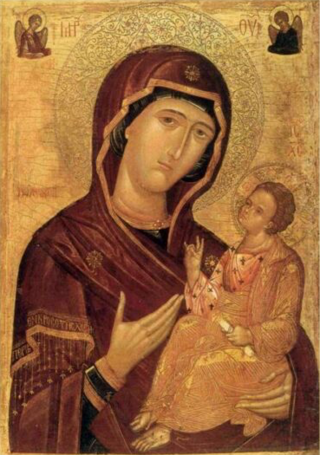
Nikolaos Lampoudis was a 15th Century Greek painter from Sparta. The only work of his of which historians are aware is an icon of the Virgin and Child of a kind known as a hodegetria or eleusa.

Georgios Kalliergis or Kallergis was a Byzantine Greek painter. He is one of the few Greek painters of the Byzantine empire known by name. Other Byzantine painters include: Theodore Apsevdis, Kokkinobaphos Master, and Ioannis Pagomenos. Kalliergis was one of the masters of Thessaloniki. He was part of the Macedonian School of painting. His last name Kallergis was associated with a noble family from the island of Crete. Two other very famous Greek painters Nikolaos Kallergis and Christodoulos Kalergis shared the same last name. Georgios was associated with Mount Athos, Veria, and Thessaloniki. His most notable frescos are in the Church of the Resurrection of Christ in Veria, Greece.
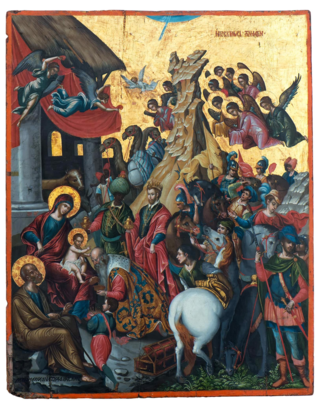
Adoration of the Kings also known as the Adoration of the Magi is a popular tempera painting by Greek painter Michele Damaschino. The painting is roughly the same size as Damaschino's The Last Supper. Both paintings were created around the same period. Michele Damaschino painted in parts of Italy and Greece. He was primarily active in Heraklion, Sicily, and Venice. He is a major representative of the Cretan Renaissance. He was a Cretan Renaissance painter who painted in the Greek mannerisms prevalent at the time. He also blended the style with the Venetian technique creating a new prototype of painting. He was followed by countless artists both Greek and Italian. His version of the Adoration of the Kings is a very important painting because it reveals the mixture of painting styles prevalent in most of his works. The Adoration of the Kings is now in the Monastery of Agia Aikaterini in Heraklion, Crete. It is part of the collection of Saint Catherine's Monastery Mount Sinai, Egypt.

Saint Anne with the Virgin is a tempera painting attributed to the Greek painter Angelos Akotantos. Angelos Akotantos is one of the founding members of the Cretan School along with Andreas Ritzos, Andreas Pavias, and Nikolaos Tzafouris. Angelos Akotantos was active during the first half of the 15th century. According to the Institute of Neohellenic Research, fifty paintings are attributed to Angelos Akotantos.
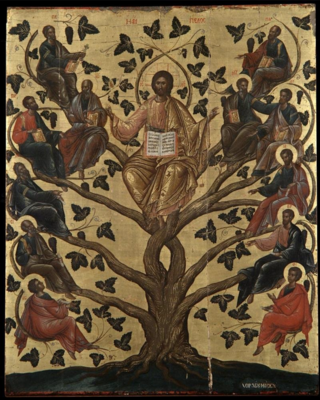
Christ the Vine also known as the Tree of Christ is a tempera painting by Leos Moskos. Moskos was active from 1620 to 1690. Twenty of his works have survived. He was originally from Rethimno, Crete. He traveled all over the Venetian empire. He worked on the Ionian islands of Cephalonia and Zakynthos. He also worked in Venice. Two other painters with the same last name were active during the same period. They were Elias Moskos and Ioannis Moskos. All three artists painted in the same style. Leos was in Venice around the same period as Ioannis. There is strong evidence that the three were related. Famous Greek painter and historian Panagiotis Doxaras was Leo’s student.
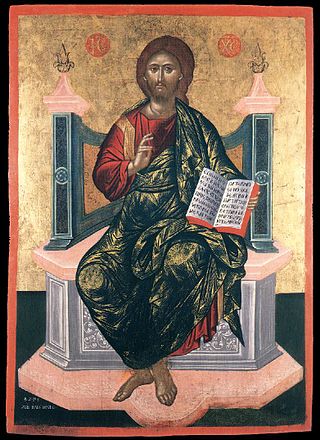
Christ Enthroned was a tempera painting created by Elias Moskos. Moskos was a representative of the Late Cretan School. The artist was also associated with the Heptanese School due to his migration to Zakinthos and the transition of his painting style. Moskos also taught painting. Most of his students became church committee members. Church committees were responsible for commissioning paintings. He was active from 1645 to 1687 on the islands of Crete, Zakynthos, and Kefalonia. Fifty-two of his works survived, over half of them were signed. Two other painters named Moskos were active during the same period Ioannis Moskos and Leos Moskos.
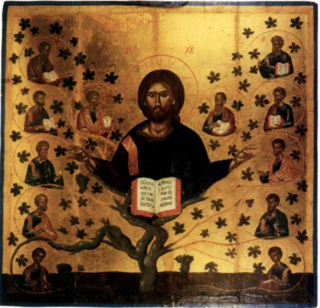
Christ the Vine is a tempera painting created by Greek painter Angelos. Angelos was active from 1425 to 1457. He was a teacher and protopsaltis. His students included some of the most famous painters of the early Cretan Renaissance. Andreas Pavias and Andreas Ritzos were his students and were heavily influenced by his style. Forty-nine of his works survived. Angelo’s Christ the Vine was one of his most important works.
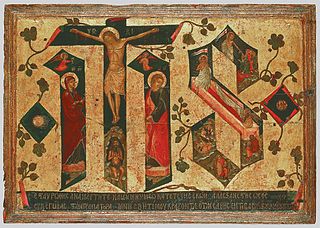
Jesus Hominum Salvator is a tempera painting by Andreas Ritzos. Ritzos was one of the founders of the Cretan School of painting. His teacher was Angelos Akotantos. Andreas Ritzos was active from 1436 to 1492. He painted in the traditional Greek-Italian Byzantine style combined with Italian Renaissance Venetian painting. The technique later became known as the maniera greca. Sixty of his works survived.
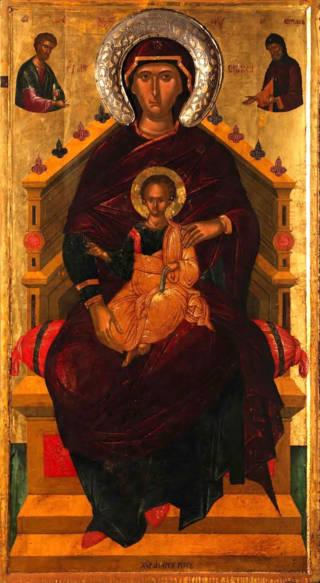
The Virgin Pantanassa is a tempera painting by Andreas Ritzos. Ritzos was a Greek painter active on the island of Crete. He flourished from 1435 to 1492. The painter has an existing catalog of over sixty works attributed to him. He signed his works in both Greek and Latin. He is one of the most influential painters of the Cretan Renaissance. He painted in the traditional Greek-Italian Byzantine style. His work was also heavily influenced by Venetian painting. His teacher was Angelos Akotantos. He was also affiliated with Andreas Pavias. His son was famous Greek painter Nikolaos Ritzos. Ritzo's Italian contemporaries were Paolo Uccello and Fra Angelico. They all painted a mixture of the Greek-Italian Byzantine and Italian Renaissance styles. The art of Crete was heavily influenced by the founder of the Venetian school Paolo Veneziano.

The Virgin and Child on Bronze is an egg tempera painting by Greek painter Elias Moskos. Moskos was originally from Crete. The painter migrated to Zakinthos. Two other painters with the name Moskos were active during his lifetime. They were Ioannis Moskos and Leos Moskos. All three painters were affiliated with Venice. Fifty-two of Elias's paintings survived. It is difficult to characterize the work of some painters belonging to the late Cretan School. Some artists also belong to the Heptanese School. The technical migration from the maniera Greca of Cretan-Venetian painting to the more refined Ionian-Venetian style is visible in the works of Elias Moskos and Theodoros Poulakis. His painting of the Virgin and Child drastically migrates from the traditional mannerism prevalent in Cretan painting. The painting clearly belongs to the Heptanese School. His painting of the Virgin and Child is at the Benaki Museum in Athens Greece.

The Nativity is an egg tempera painting by Victor. Victor is sometimes referred to as Victor of Crete. Victor was active from 1645 to 1696. He traveled all over the Venetian empire. He settled in Zakinthos. Some of his important works can be found in the church San Giorgio dei Greci in Venice. He is a very important Greek painter because of his existing catalog. His works of art exceed ninety-five paintings. One of his notable works was his version of Christ the Vine.
